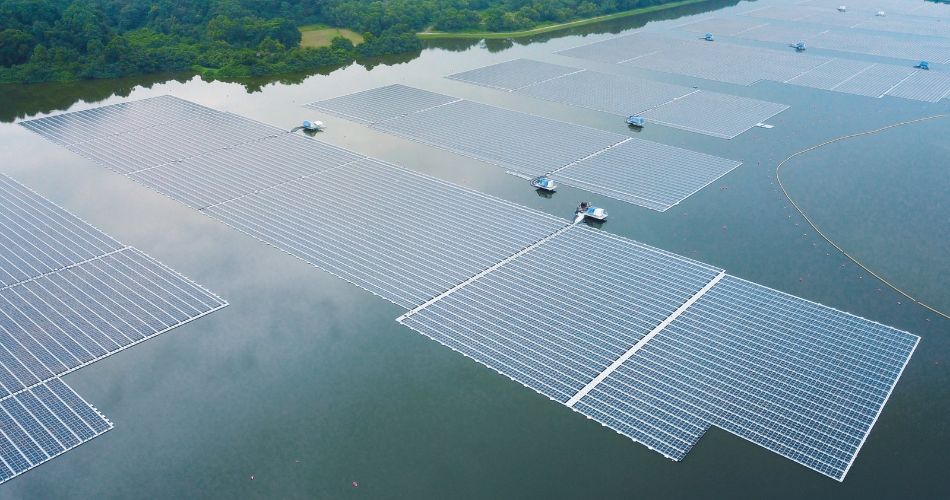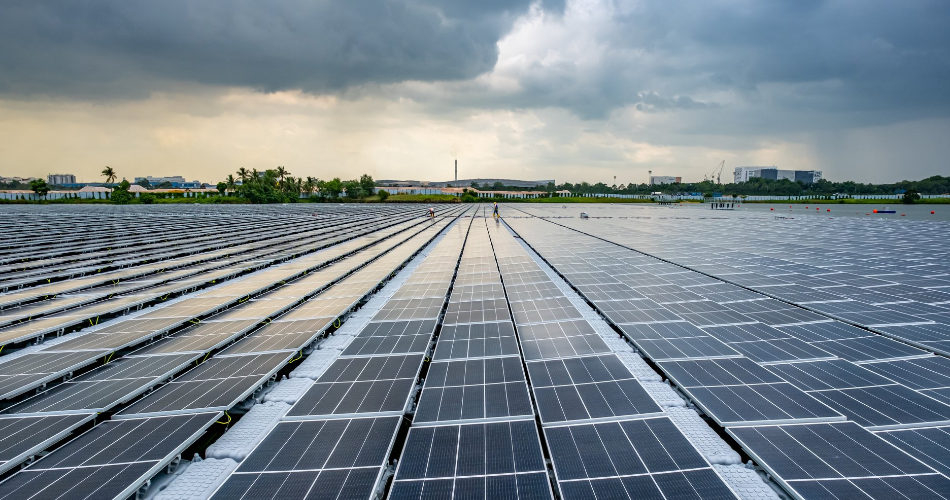Published 1 December 2021 ● Last Updated on 1 December 2021
That humanity needs to de-addict itself from fossil fuels is a foregone conclusion. But if not coal, oils and natural gas… then what? In the race to restrict global warming to under 1.5°C this century, how we ramp up renewable power in the global energy mix – from 25% currently to 85% by 2050 – will be key.
To see what a sustainable future of energy looks like, we reached out to Sembcorp Industries – a key player in the Singapore energy market. It contributes more than 10% of Singapore’s total electricity generation capacity in 2020, and is a component stock of the Straits Times Index. The company has ambitions to halve absolute emissions by 2030 and net-zero by 2050. In that direction, its renewable projects are not only increasing in size and efficiency, but also catching the public eye with innovation.
Take for instance, the Tengeh floating solar farm, spread across 45 hectares and one of the world’s largest inland floating solar photovoltaic (PV) systems. With a feted opening in July 2021, the project aims to offset about 7% of annual energy needs of Singapore’s national water agency – Public Utility Board (PUB). Here’s a bird’s eye view of the project:
Footage Credit: Sembcorp.
In conversation with Jen Tan, Head of Integrated Solutions (Singapore & Southeast Asia) at Sembcorp Industries, we explore the floating solar farm project’s sustainability quotient. We also get insights on the future of energy, especially in land-scarce urban environments like Singapore.
Q: As innovation goes, Sembcorp’s Tengeh floating solar farm sets a novel precedent – situated on a water reservoir, and executed in under 12 months despite the Covid challenges! Can you share some broad strokes on the scope of the project?
With 122,000 solar panels spanning across 45 hectares, the 60 megawatt-peak (MWp) Sembcorp Tengeh Floating Solar Farm is one of the world’s largest inland floating solar photovoltaic (PV) systems. The electricity generated from the solar farm will be sufficient to power Singapore’s five local water treatment plants.
Construction commenced in August 2020 and it was completed in less than a year with full safe management measures in place, despite manpower and supply chain constraints due to the unprecedented COVID-19 pandemic. New and innovative ways of working were needed to mitigate the impact, and one such way was conceptualising and implementing a new engineering and construction technique to design a custom-built jig that increased the rate of solar panel assembly by up to 50%.
The floating solar farm was also carefully designed to minimise impact on the reservoir’s water quality, flora and fauna. Sufficient gaps between solar panels were incorporated to improve the airflow and allow sufficient sunlight to reach aquatic life. Additional aerators were also put in place to maintain oxygen levels in the reservoir.
Floats deployed are made using high-density polyethylene (HDPE) – a certified food-grade material that is recyclable, UV-resistant and corrosion resistant. In addition to having a comprehensive environmental management and mitigation plan, PUB and Sembcorp will continue to monitor the reservoir closely, and take necessary measures to maintain biodiversity and water quality.
Q. Given the project’s location on a reservoir, one can’t help but wonder how it impacts the ecology in and around the reservoir. Were any steps taken to mitigate potential impacts on biodiversity?
PUB’s main concern with deploying solar panels on reservoirs was the potential impact on the surrounding environment, biodiversity and water quality. The comprehensive Environmental Impact Study, which included biodiversity surveys, water quality monitoring and modelling, along with consultations with nature groups was carried out between 2015 to 2018. Results from PUB’s testbed deployed at Tengeh Reservoir in 2016 also showed no observable change in water quality nor significant impact on surrounding wildlife.
Q. Tengeh will go on to power 100% energy needs for all 5 water treatment plants for Singapore’s National Water Agency PUB. That is a milestone for Singapore – to have a 100% green water treatment system. Should we read this as a signal that more government agencies are looking to green up?
The Singapore Green Plan 2030 is one indication that our government is serious about advancing our national agenda on sustainable development, especially to decarbonise our economy. In particular, to support Singapore’s Energy Reset, solar is recognised as Singapore’s most abundant source of renewable energy. In addition to working with PUB in the development of the Sembcorp Tengeh Floating Solar Farm, we are also working on other government projects.
In March this year, Sembcorp was awarded a 60MWp solar energy project by the Housing & Development Board (HDB) and the Singapore Economic Development Board (EDB). We are building grid-tied rooftop solar systems across 1,154 HDB blocks and 46 government sites in Singapore. This project is part of the SolarNova programme, a Whole-of-Government effort led by HDB and EDB to accelerate the deployment of solar PV systems in Singapore, under the programme’s new capacity target of 540MWp on HDB blocks by 2030. Sembcorp also has two other past SolarNova projects as part of its portfolio in Singapore.
How about individuals? If I, as a consumer, want to to switch to renewable energy – can I tap on Sembcorp Power?
If you would like to join us on our journey towards a greener future, Sembcorp Power, our electricity retail arm, has created a pathway for homeowners.
Since 2019, Sembcorp Power offers solar panel installations and Renewable Energy Certificate management for the residential market. Earlier this year, we partnered with OCBC Bank to launch Singapore’s first consumer loan for the installation of residential solar panels to meet the growing demand from landed property homeowners looking to power their houses with clean energy. Households with excess electricity generated by their solar panels can also opt to sell the power back to the national electricity grid to offset its electricity costs. Homeowners can also expect to save on average more than 20% of their household electricity bill, based on Singapore Power’ regulated tariffs, when they sign up for an electricity plan with Sembcorp.
By choosing any of our electricity home plans, you can already help to create a sustainable future as we retire 50kWh worth of Renewable Energy Certificates on behalf of every customer each month. However, the more sustainability-conscious individuals can opt for our Sunshine Plan which offers 100% solar energy from our own Sembcorp Solar assets.
Editor’s note: Are you looking for a green energy provider in Singapore? Find your options here.
Q.What is your view of Singapore’s solar power goal – of moving from 350 megawatt-peak (MWp) in 2020 (that’s between 2-3% of total electricity generation capacity) to at least 2 gigawatt-peak (GWp) by 2030. Is that an easy target or smartly ambitious or somewhere in the middle?
In Singapore, solar energy is the most viable renewable energy resource and there is still a lot of room for its expansion locally. We believe the new target of two gigawatt-peak is achievable as there are still many more buildings and reservoirs that we can build solar energy systems on.
We are also witnessing more companies wanting to minimise or eradicate their carbon footprint and we are committed to meeting the growing need for such green energy. In addition, Singapore’s vertical space can also be leveraged to grow solar power and if such technology proves fruitful, we can definitely achieve even more.
Q. How important are solutions such as floating and rooftop installations in the urban cities story? Can solar solutions completely replace fossil fuel energy?
Solar solutions not only help to reduce dependence on fossil fuels and thus carbon emissions, but also build national climate resilience for a more sustainable future. However, intermittency* is still one of the major criticisms of solar power. But one possible way to counter this and enhance the overall stability and resilience of the grid lies in energy storage solutions. Energy storage is a critically important technology that is gaining momentum globally and we believe will be a game changer especially in the clean energy space. Energy storage solutions can work synergistically with Sembcorp’s other power generation assets including conventional gas-fired generation to create more value too.
*Editor’s Note: Intermittency refers to the variability of a power source. In the case of solar, it has two aspects: the predictable diurnal and seasonal cycle, and the unpredictable weather.
Q. Going by the IPCC report, unless we de-addict from fossil fuels, and fast, we’re on course for a global temperature rise of more than 2 degrees compared to the Industrial era – which will be catastrophic. Does Sembcorp recognise this urgency? The company’s sustainability goals aim to halve absolute emissions by 2030 and net-zero by 2050. How do you plan to achieve these?
With the rapidly evolving energy landscape and the move towards a low-carbon economy – repositioning our energy business to strategically benefit from the global energy transition and navigate disruption is an important thrust of the company’s strategy.
Today, we are one of the largest home-grown renewable energy players with a renewable energy portfolio comprising solar, wind and energy storage in key markets such as Singapore, China, India, UK and Vietnam, and we continue to target growth in this sector.
In May 2021, we unveiled a more detailed strategic plan to transform our portfolio from brown to green, with growth driven by our renewables and integrated urban solutions businesses. And we have clear targets set as part of this transformation plan. By 2025, we aim to quadruple our gross installed renewable energy capacity to 10 gigawatts (GW). In 2020, our gross installed renewable energy capacity, comprising wind, solar and energy storage was 2.6 GW.
Related Articles
Eco Home| Are you looking for a green energy provider in Singapore?
Should you buy carbon offsets? | The solution when your best efforts aren’t good enough!






0 Comments